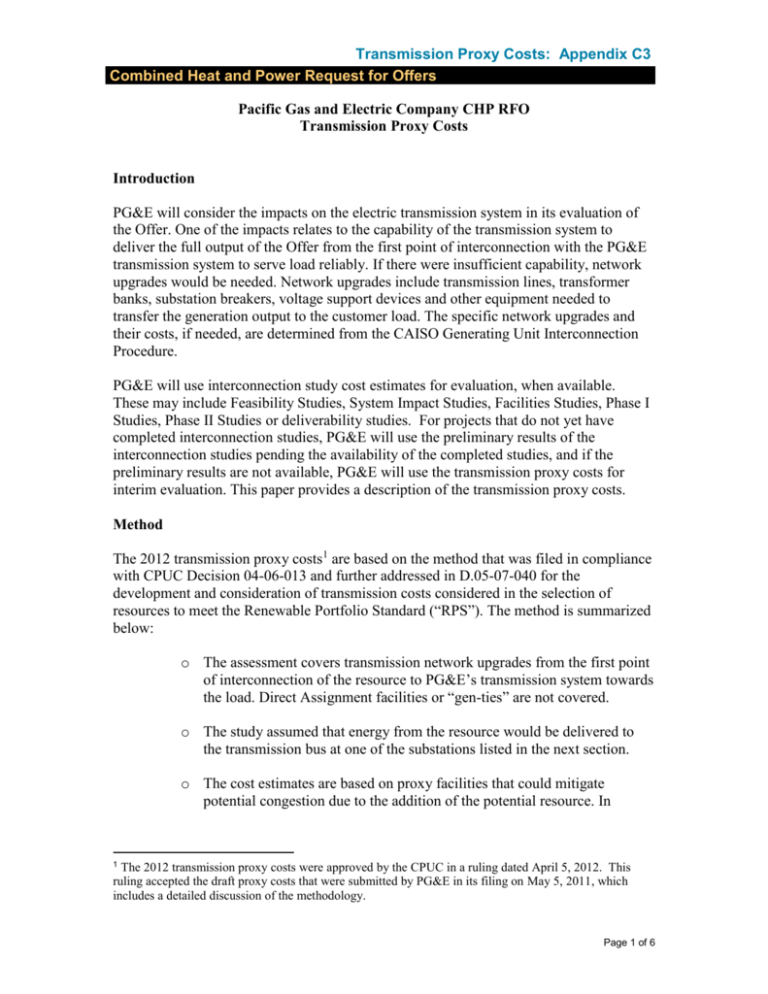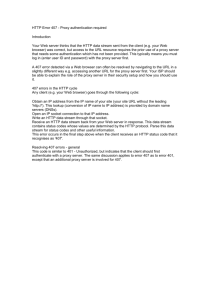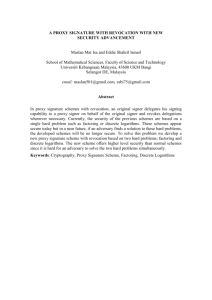Appendix C3: Electric Transmission Proxy Costs
advertisement

Transmission Proxy Costs: Appendix C3 Combined Heat and Power Request for Offers Pacific Gas and Electric Company CHP RFO Transmission Proxy Costs Introduction PG&E will consider the impacts on the electric transmission system in its evaluation of the Offer. One of the impacts relates to the capability of the transmission system to deliver the full output of the Offer from the first point of interconnection with the PG&E transmission system to serve load reliably. If there were insufficient capability, network upgrades would be needed. Network upgrades include transmission lines, transformer banks, substation breakers, voltage support devices and other equipment needed to transfer the generation output to the customer load. The specific network upgrades and their costs, if needed, are determined from the CAISO Generating Unit Interconnection Procedure. PG&E will use interconnection study cost estimates for evaluation, when available. These may include Feasibility Studies, System Impact Studies, Facilities Studies, Phase I Studies, Phase II Studies or deliverability studies. For projects that do not yet have completed interconnection studies, PG&E will use the preliminary results of the interconnection studies pending the availability of the completed studies, and if the preliminary results are not available, PG&E will use the transmission proxy costs for interim evaluation. This paper provides a description of the transmission proxy costs. Method The 2012 transmission proxy costs1 are based on the method that was filed in compliance with CPUC Decision 04-06-013 and further addressed in D.05-07-040 for the development and consideration of transmission costs considered in the selection of resources to meet the Renewable Portfolio Standard (“RPS”). The method is summarized below: o The assessment covers transmission network upgrades from the first point of interconnection of the resource to PG&E’s transmission system towards the load. Direct Assignment facilities or “gen-ties” are not covered. o The study assumed that energy from the resource would be delivered to the transmission bus at one of the substations listed in the next section. o The cost estimates are based on proxy facilities that could mitigate potential congestion due to the addition of the potential resource. In 1 The 2012 transmission proxy costs were approved by the CPUC in a ruling dated April 5, 2012. This ruling accepted the draft proxy costs that were submitted by PG&E in its filing on May 5, 2011, which includes a detailed discussion of the methodology. Page 1 of 6 Transmission Proxy Costs: Appendix C3 Combined Heat and Power Request for Offers developing the proxy facilities, results from other studies previously published by PG&E would be used where appropriate. Transmission Proxy Costs PG&E has developed the transmission proxy costs at the transmission bus for twenty two substations as shown in Table 1. The approximate locations2 of these are shown in Figure 1. The transmission proxy costs for the peak and off peak periods3 are included in Table 1. The transmission proxy costs are based on potential transmission congestion, associated proxy network upgrades, and associated capital costs that may be needed to accommodate each substation representing the approximate location of renewable resources. For each substation, PG&E has identified several levels of possible additional transmission capacity and the related costs. Level 1 reflects the available transmission capacity after taking into account all approved reliability and economic transmission projects as well as upgrades planned for generation projects in the ISO interconnection queue based on their completed interconnection studies. Thus, Level 1 would have no network upgrade costs except those associated with reactive power support. The next and subsequent levels reflect the next most cost-effective proxy network upgrade(s). The number of levels depends on the number of proxy network upgrades needed to accommodate up to maximum expected amount of new generation in each substation. Applications of Transmission Proxy Costs It is important to note that the transmission proxy costs will be used solely for the purpose of ranking and evaluating Offers. The actual transmission network upgrade costs for a specific project, determined by the interconnection studies, may differ from the transmission proxy costs and PG&E is not responsible or liable for the deviation between estimated and actual costs. Transmission Proxy Costs will not be applied to existing or utility pre-scheduled facilities. 2 PG&E has no prior knowledge where the new resources may be located and the substation selections are based on their locations (near gas transmission lines and spread out within NP15) and size (transmission level bus). Peak period is HE (hours ending) 7-22, Monday – Friday (except NERC holidays) for months Jun – Sep. Off peak period is the other hours. 3 Page 2 of 6 Transmission Proxy Costs: Appendix C3 Combined Heat and Power Request for Offers Table 1. Transmission Proxy Costs Page 3 of 6 Transmission Proxy Costs: Appendix C3 Combined Heat and Power Request for Offers Page 4 of 6 Transmission Proxy Costs: Appendix C3 Combined Heat and Power Request for Offers Page 5 of 6 Transmission Proxy Costs: Appendix C3 Combined Heat and Power Request for Offers Figure 1 PG&E Substations Associated with the CHP RFO Captain Jack Pacific Gas and Electric Co. (PG&E) Malin Oregon California Pit 1 Humboldt Olinda Delta Metering Station Round Mt. Caribou Table Mt. Summit Cottonwood Bellota Fulton Rio Oso Vaca-Dixon Wilson Tracy Stagg Tesla Newark Gregg Metcalf Helm Los Banos Gates Panoche Midway Morro Bay Carrizo Plains Renewable resource Cluster Southern California Edison (SCE) Sylmar Vincent Page 6 of 6








